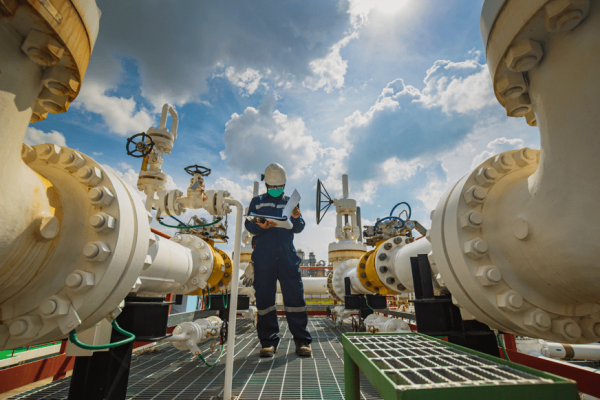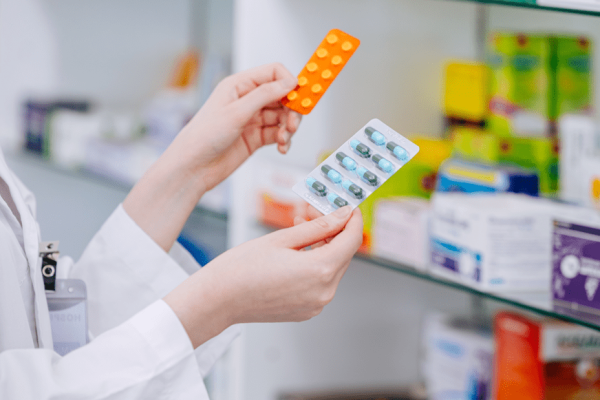How Much Do People in Kazakhstan Spend on Medicines?
25 September 2025
718
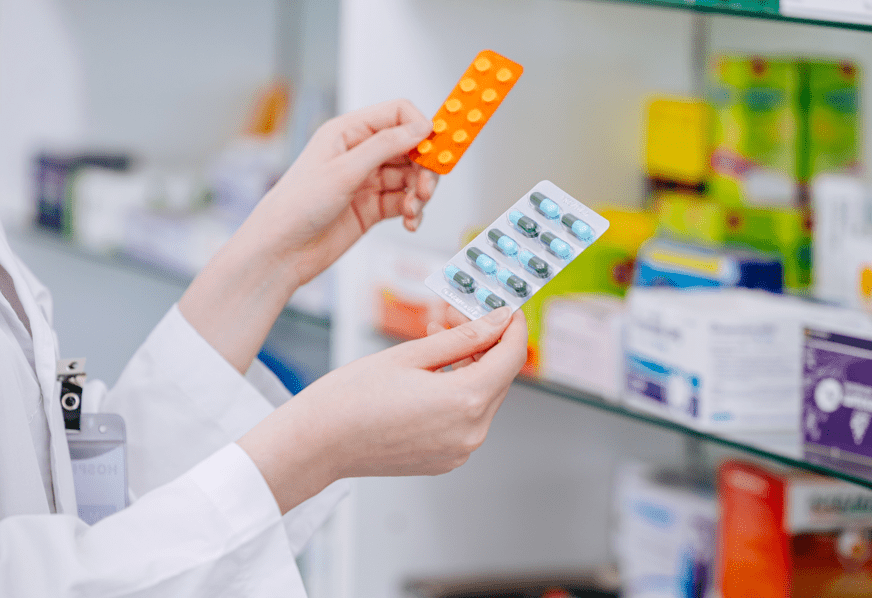
In the second quarter of this year, household healthcare spending in Kazakhstan averaged 28.8 thousand tenge per household, 6.6% less than in the same period of 2024.
The main share of expenditures went to medicines, medical equipment, and devices: 13.3 thousand tenge per household per quarter—almost the same as a year earlier (down 0.9%). Of this amount, households spent 12.1 thousand tenge on pharmaceutical products, 913 tenge on medical equipment and devices, and 300 tenge on other medical goods.
By region, the highest spending on medicines, equipment, and devices was recorded in Karaganda Region: 18.4 thousand tenge per household, 0.2% less than a year earlier. North Kazakhstan Region (16.7 thousand tenge) and Almaty (16 thousand tenge) ranked second and third. The lowest spending in this segment was observed in Zhetysu Region (7 thousand tenge), West Kazakhstan Region (8.6 thousand tenge), and Mangystau Region (9.8 thousand tenge).
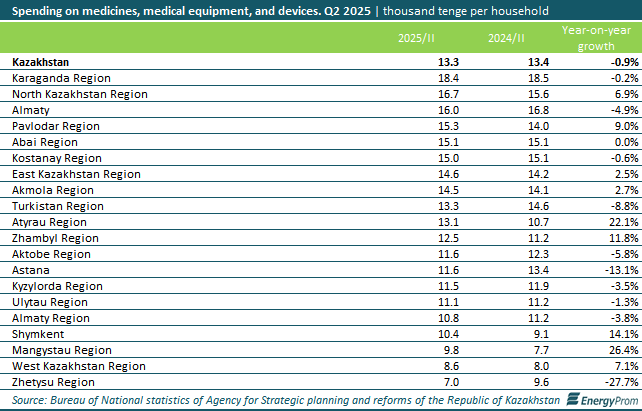
How did pharmaceutical prices change? As of August this year, they rose by 1.5% month-on-month and by 9.9% year-on-year.
Among the medicines regularly monitored by the Bureau of National statistics of Agency for Strategic planning and reforms of the Republic of Kazakhstan, the sharpest monthly increases were recorded for activated charcoal (up 10.7%), acetylsalicylic acid (up 4.1%), No-Spa (up 4%), Canephron N (up 3.8%), Corvalol (up 3.3%), Aqualor Forte (up 2.5%), and Smecta (up 1.6%). Not all drugs rose in price, however: Fenistil New dropped by 0.1%, Flemoxin Solutab by 0.3%, Suprastin by 0.4%, Rennie by 0.8%, and Aciclovir by 1.5%.
On an annual basis, the steepest increases were observed for Corvalol (up 29.8%), Canephron N (up 28.1%), activated charcoal (up 24.6%), acetylsalicylic acid (up 20.8%), Aciclovir (up 17%), Suprastin (up 15.1%), and Enap (up 13%). The only drug to decline in price year-on-year was Nurofen, which fell by 0.7%.
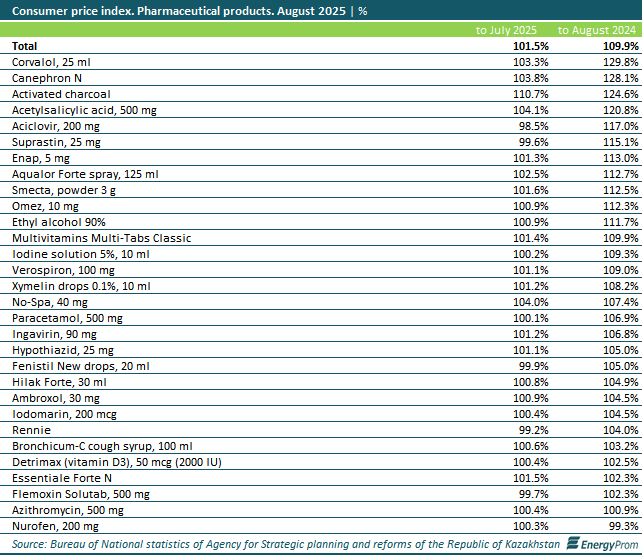
As for sector output, in January–August of this year, the production of basic pharmaceutical products and pharmaceutical preparations in Kazakhstan amounted to 121.3 billion tenge, up 5.7% in value terms compared to the previous year. Within this, the output of pharmaceutical preparations and medical supplies rose by 6% to 116.9 billion tenge, while the production of basic pharmaceutical products declined slightly by 0.1% to 4.4 billion tenge.
Regionally, the largest share of output came from Shymkent, at 45.6 billion tenge, representing year-on-year growth of 10.6%. Almaty Region (28.8 billion tenge, up 4.2%) and Karaganda Region (22.7 billion tenge, up 1.2%) also ranked among the top three. Rounding out the top five producers were Almaty (16.1 billion tenge, up 1.3%) and Aktobe Region (2.8 billion tenge, up 24.6%).
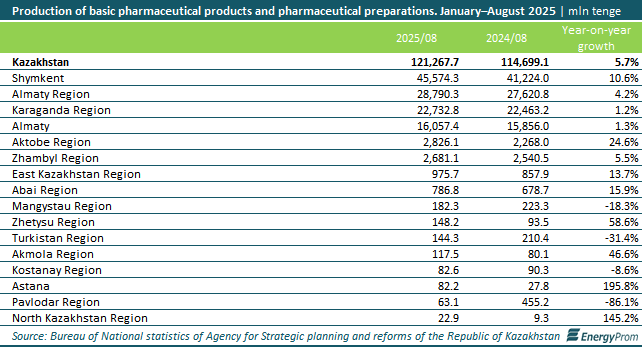
Now turning to imports. In January–July of this year, Kazakhstan imported 17.8 thousand tons of medicines worth 1.2 billion US dollars—significantly less than in the same period of 2024. The decline amounted to 18.6% in volume terms and 4.7% in value terms.
From CIS countries, 5.4 thousand tons of medicines worth 90.4 million US dollars were imported. Russia accounted for the bulk of these shipments with 4.2 thousand tons. Belarus (569 tons) and Ukraine* (539.2 tons) also ranked among the top three suppliers.
From outside the CIS, Kazakhstan imported 12.4 thousand tons of medicines worth 1.1 billion US dollars. China was the leading supplier, delivering 3.5 thousand tons. India, Germany, France, and Turkey also ranked among the top five exporters.
* Ukraine’s status within the CIS is disputed for a number of reasons.
Popular articles
Watch allWho and why does Kazakhstan’s saiga antelope give trouble?
Experts question the department’s statistics, as well as decisions made at state level regarding saigas In early summer, there Читать далее...
28 June 2022
2987
Gas Production Declined, While Prices Jumped 28% Year-on-Year
In January–July of this year, natural gas production in Kazakhstan amounted to 14.8 billion cubic meters, down 10.3% compared with Читать далее...
17 September 2025
1926
Electric Vehicles Accounted for Less Than 1% of All Registered Cars in Kazakhstan
From January to July of this year, 925.8 thousand passenger cars were registered in Kazakhstan, 0.3% more than in the Читать далее...
28 August 2025
1559
Kazakh oil refineries supplied 73.3% of motor fuel consumed and 97.4% of diesel fuel consumed in the country. Petrol output increased by 10.6% and production of gasoils by 3.6%
The price of the most popular octane-93 petrol increased by 16.4% year on year to KZT125 per litre in July. The price of summer diesel increased by 3.3% year on year to KZT99 per litre
15 September 2016
1371
Power generation reaches 53.7bn kWh in January-July, up by 1.7% year on year. Gas turbine power plants with a capacity of 100,000 kW worth KZT18.6bn were commissioned in the first half of the year
Electricity tariffs went up by 5.8% year on year in August
16 September 2016
1290
Industrial enterprises navigate to sustainable development
Major industrial companies’ investments into social and infrastructure projects in 2019 exceeded 140 billion Tenge Kazakhstan has been holding Читать далее...
5 November 2021
1231
Safeguarding the nature: investment into environmental protection increased by 34% over the year
The number of fixed point sources of pollution in 10 years has increased by 58% Environmental issues are extremely Читать далее...
5 November 2021
1117
“Pirating” in Kazakhstan: 59% of Young People Use Free Platforms to Watch Films and Series
According to the analytical report Youth of Kazakhstan for 2024, one of the most common leisure activities among young people Читать далее...
26 September 2025
1067
Focus on ESG: the world is confidently switching to green rails and sustainable development principles
In Kazakhstan, only some of the major backbone companies, major market players, and national development institutions are ready to implement Читать далее...
5 November 2021
1033
Which Social Networks and Messengers Do Kazakhstan’s Young People Prefer?
According to the analytical report “Youth of Kazakhstan” for 2024, one of the most common ways young people spend their Читать далее...
9 October 2025
975
Renewable energy generation capacities goes up by 40% year-on-year in Kazakhstan in 1Q2016
Clean energy generation jumps by 130% year-on-year in this period
22 June 2016
973
Production of equipment for the oil and gas sector increases by 82.5% year on year in January-July 2016
The sector is boosted by key projects such as the launch of oil production at the Kashagan field expected in the fourth quarter of this year
1 September 2016
800
Kazakhstan’s crude oil and gas condensate output fall by 3.4% year on year in January-July 2016
In July 2016 crude oil and condensate went down by 0.9% year-on-year
26 September 2016
786
Kazakhstan’s industrial output goes down by 2.2% year on year in Jan-Apr 2016
Kostanay Region becomes regional outsider with 15.7% slump
11 July 2016
768
How Much Do People in Kazakhstan Spend on Medicines?
In the second quarter of this year, household healthcare spending in Kazakhstan averaged 28.8 thousand tenge per household, 6.6% less Читать далее...
25 September 2025
718











